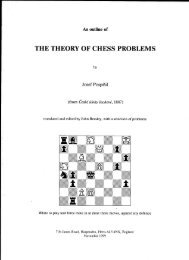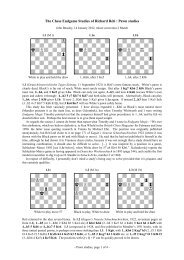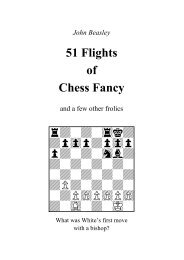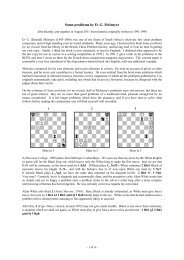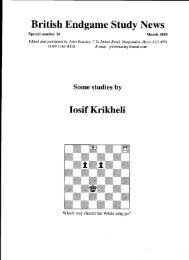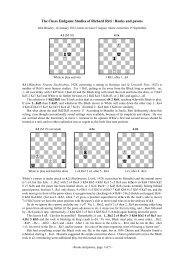A tribute to G. W. Chandler - John and Sue Beasley
A tribute to G. W. Chandler - John and Sue Beasley
A tribute to G. W. Chandler - John and Sue Beasley
Create successful ePaper yourself
Turn your PDF publications into a flip-book with our unique Google optimized e-Paper software.
Two-movers 15<br />
13 (The Problemist, January 1957). Most of <strong>Ch<strong>and</strong>ler</strong>’s best problems were<br />
characterized by good keys, <strong>and</strong> in his later years he sometimes reverted quite<br />
unashamedly <strong>to</strong> the ancient style in which the key was the whole point of the<br />
problem. Black has several harmless moves here <strong>and</strong> it is natural <strong>to</strong> look for a<br />
threat, but in fact the problem is a waiter; the splendid key 1 Qh5 sets up the<br />
ambush 1...Bh3/Bf5 2 Qd1, <strong>and</strong> if Black plays 1...Be6 <strong>to</strong> counter this then 2 Qh2.<br />
14 (1st Prize, The Problemist, May 1957). This is of heavier metal. The<br />
flight-creating move 1...b3 needs attention, so the key 1 Ra5 (threat 2 Qd5) comes<br />
as no real surprise, but there is a richness in the play after Black’s various moves<br />
<strong>to</strong> d6: 1...Bd6 2 Qxe6, 1...Rcd6 2 Qa4, 1...Red6 2 Nxe5, <strong>and</strong> 1...Nd6 2 Qxc6.<br />
Another interference is exploited in the line 1...Nf4 2 Nd2, <strong>and</strong> two self-blocks<br />
round off the problem: 1...Nc3 2 Nb2 <strong>and</strong> 1...Rc5 2 Ra4.<br />
15 (Radio Times, 11 November 1958). <strong>Ch<strong>and</strong>ler</strong> was never ashamed <strong>to</strong> put<br />
his name <strong>to</strong> simple introduc<strong>to</strong>ry problems for the wider audience, <strong>and</strong> this, which<br />
was produced as an illustrative example for a radio programme, is perhaps the best<br />
of several “queen <strong>to</strong> the corner” problems which he made over the years.<br />
A routine survey of the position shows that the flight-creating move 1...Nxb8<br />
needs attention, so the key 1 Qa8 (1...N-- 2 Qa1) is soon found by an experienced<br />
solver, but it gives a flight on g7 <strong>and</strong> the line 1...Kxg7 2 Be5 is distinctly pleasant.<br />
If 1...fxe6 then the rook guards g7 <strong>and</strong> 2 Qf3 works. A prominent Black move<br />
which must be answered is arguably a good feature at this introduc<strong>to</strong>ry level,<br />
particularly if it provides a short cut <strong>to</strong> a striking key.<br />
16 (Busmen’s Chess Review, August 1971). The flight-creating move 1...b3<br />
needs attention, so the key 1 Qc3, threatening 2 Qe5, is likely <strong>to</strong> be among the<br />
moves tried early despite its exposure of the White king <strong>to</strong> check, <strong>and</strong> the matter<br />
becomes a certainty once we realize that the capturing check 1...bxc3+ diverts the<br />
pawn <strong>and</strong> allows 2 Rb5. The play of the knight at g7 leads <strong>to</strong> two interferences<br />
<strong>and</strong> a self-block, 1...Ne8 2 f8N, 1...Nh5 2 Qh3, <strong>and</strong> 1...Nf5 2 Rd6, <strong>and</strong> a further<br />
self-block line 1...Qd6 2 Re5 rounds off the problem. <strong>Ch<strong>and</strong>ler</strong> had used the same<br />
key back in 1911, but I think this later problem the better of the two.<br />
17 (The Problemist, May 1972). <strong>Ch<strong>and</strong>ler</strong> describes this in his scrapbook as<br />
“an attempt <strong>to</strong> sharpen the key of 16”, <strong>and</strong> it proved <strong>to</strong> be a highly successful<br />
attempt. Again the flight-creating move 1...b3 needs attention, but 1 Qa3 (1...b3<br />
2 Re5) is hardly the most obvious way of dealing with it. There is no threat, but<br />
the capture 1...bxa3 again diverts the pawn, this time allowing 2 Rdxd7, <strong>and</strong> other<br />
play includes the self-block lines 1...d6 2 Re5 <strong>and</strong> 1...Nf7 2 Rxg6. <strong>Ch<strong>and</strong>ler</strong> set<br />
this up on a board at one of the first BCPS meetings I attended, <strong>and</strong> the spectacular<br />
key stuck in my mind. There was <strong>to</strong> be a sequel, as we shall see.<br />
18 (2nd HM, BCF Tourney, 1973). We have seen several problems based on<br />
the play of one Black knight; here there are two. The key 1 Bg1 threatens 2 Qb2,<br />
<strong>and</strong> we have three variations by the knight on the left, 1...Nb3 2 Nc4, 1...Nc4 2 d6,<br />
<strong>and</strong> 1...Nc6 2 Nxd7, <strong>and</strong> three more by that on the right, 1...Ng2 2 Qh5, 1...Nf3<br />
2 Qe2, <strong>and</strong> 1...Nf5 2 Rxe6. Problems based on variations from the moves of two<br />
men are common enough, but it is unusual for the men <strong>to</strong> be quite so far apart.



